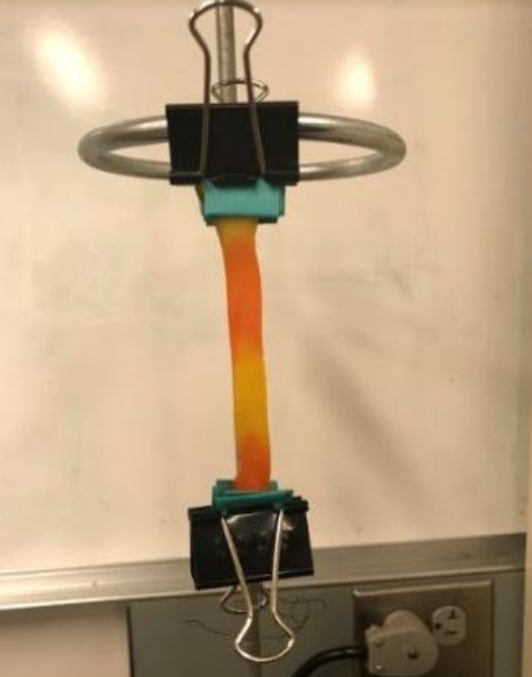November Visit on November 18, 2022
Experiment Leaders: Adaire Nehring and Ela Engen
The visits at Heritage STEM Academy are 2 hour visits. This allowed Science for All (SFA) graduate student mentors to design two related experiments regarding the mechanics of materials. We started by having a brief presentation explaining to the students what is meant by “the mechanics of materials.” The presentation contained definitions of stress, strain, deformation, tensile, compressive, and more! After, the students were separated into groups of 2-3 with one graduate student mentor at each station. The first experiment was determining the tensile strength of different types of candy. Each group chose two different candies to test out of three options: airheads, gummy worms, or red vines. They set up the testing mechanism as shown in the image below and slowly added weights in increments of 50 grams to the bottom binder clip. At each step, the students compared the new length of the candy to the original length. Weights were added until either the candy broke or they ran out of weights (~500 grams). The tensile strain data was then plotted on a load vs strain graph to compare the strengths and stiffnesses of the two candies. If there was still time in the hour set aside for this experiment, the groups were given pull-apart Twizzlers to compare the strength of different numbers of strands. The goal was to show that the geometry of the Twizzlers strands could modify the strength in a non-linear way. The more twist (from more strands) would be stronger than the same number of unconnected strands. The students were very engaged in this experiment and showed understanding of tensile strain concepts.

The second half of the visit, we did an experiment focusing on the compressive strength of different materials. The goal of this experiment was to learn which materials had the greatest plastic deformation. In the same groups, the students chose at least 3 different materials to test. They recorded the initial area and height of the materials then selected a weight to add and record the change in height. In this experiment they calculated both the stress and strain of the materials. They repeated the experiment with two more trials and plotted the stress vs strain. Since the materials could be different sizes based on some of the options (play-doh squares, jello squares, etc.), it was important to normalize the area and height by calculating the stress (load/area) and strain (change in length/original length). Some materials, like peppermints, didn’t deform based on the weights we had and required extra outside force by “whacking” the material to fracture. These materials didn’t have plastic deformation and instead went straight to fracture. The students enjoyed these compression experiments and learned how different materials deform. Overall these two experiments were successful in teaching the student about material mechanics.